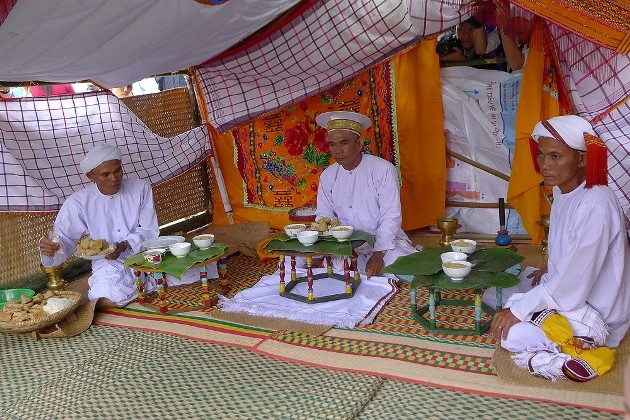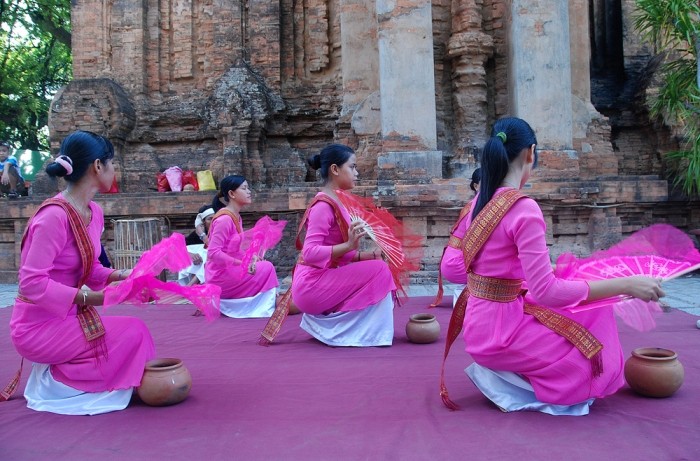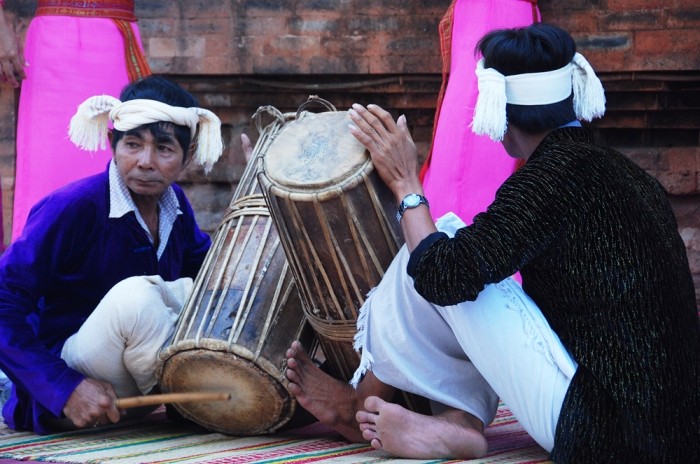(VOVworld) – The Cham ethnic groups speak a dialect of the Malayo-Polinesian language and are related to the Raglai, Ede, Chu Ru and Gia Rai groups in Vietnam. The Cham people share ethnic similarities with Indonesians, Malaysians and Bruneians in South East Asia. In Vietnam, they are native to the south central coastal region and build their culture under the influence of Indian culture.
The Cham in Vietnam number more than 160,000, concentrated in Ninh Thuan, Binh Thuan and parts of Phu Yen, Binh Dinh, An Giang, Tay Ninh and Ho Chi Minh city. Cham villages are scattered in the south central coasts. The Cham comprises of various local groups with varying religion, belief and culture. Some attend mosques, while others practice their religion in pagodas or tower temples. Le Duy Dai of the Vietnam Museum of Ethnology says the Cham in Vietnam comprises of 4 distinct groups:
 |
| Photo: Lan Anh |
“The 4 Cham groups are different by religion. The majority of Cham in Vietnam are Cham Balamon or Hindu. The second group is Cham Bani or old Islam. The 3rd group is Islam. The 4th group, the Cham Hroi, do not follow any religion”.
 |
| Photo: Lan Anh |
The Cham Balamon and Bani live predominantly in Ninh Thuan and Binh Thuan province. The Cham Balamon call themselves indigenous Cham to distinguish themselves from the Cham Bani. The Cham Balamon follow Hinduism, while the Cham Bani follow a form of Islam that has been influened by folk belief and is isolated from world Islam.
The Cham Islam follow conventional or new Islam in contrast to the Cham Bani, who follow old Islam. The Cham Islam lives mostly in the southern delta provinces of An Giang and Tay Ninh and Ho Chi Minh City. They once migrated from Vietnam to Cambodia, but eventually returned to Vietnam and resettled in the southern delta. Nao Du, a Cham Islam living in Van Lam 4, Ninh Phuong district, Ninh Thuan province, compared the Cham Bani and Cham Islam:“The Cham Islam have 7 festivals every year. Before the fasting month of Ramadan, we go to the mosques for mass prayers and we clean and decorate ancestral graves. The Cham Bani visit thier ancestral graves before the 3-day New Year festival. Their fast lasts only 3 days, instead of 30 days like ours. A fasting day lasts from 4.30 am to 5.30 or 6 pm.”
The Cham Hroi are concentrated in Binh Dinh and Phu Yen province and are uninfluenced by any religion. They follow their primitive belief and are culturally similar to the neighboring Bana and Ede people.
 |
| Photo: Lan Anh |
Religious differences have led to differences in culture, customs, and social practices. Ethnology researcher Le Duy Dai explains:“Basically, their traditional cultures are similar. But there are some differences. For example, the Cham Balamon and Cham Bani are matriarchal, while the Cham Islam are patriarchal. Their clothing is similar. With regard to housing, the Cham Balamon and Cham Bani live in low houses on stilts, which no longer exist in Ninh Thuan and Binh Thuan. We have recreated them at the Museum of Ethnology. The floor is only 35-40 cm above the foundation. The Cham Islam in Chau Doc and the Cham Hroi live in high houses on stilts.”
On the next edition of Colorful Vietnam – Vietnam’s 54 ethnic groups, we will tell you more about the Cham matriarchy.